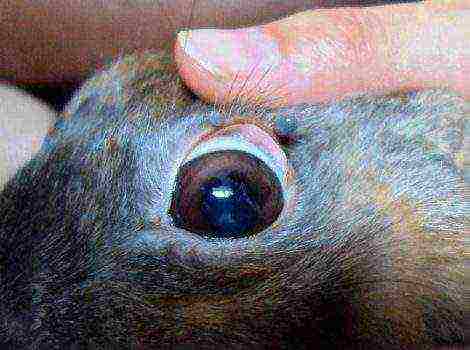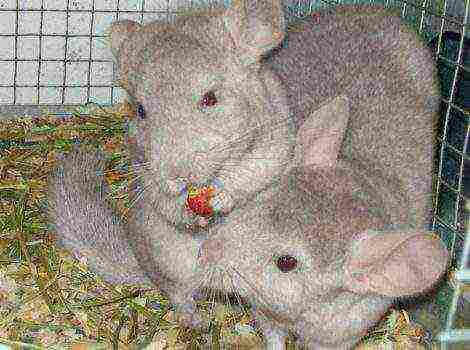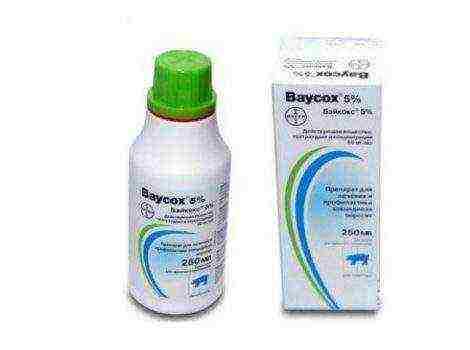Content [show]
Instructions for use of the drug Baytril for rabbits
Rabbits are often bred in the household because the meat of these animals tastes good and their skins are of great value. And in food, these animals are not whimsical enough. But everything would be fine if it were not for the high susceptibility of rabbits to various infectious diseases. And this happens due to the inexperience and ignorance of the owner of the farm.
Experienced rabbit breeders advise doing prophylaxis to rabbits from the first month of life., Baytril can be used as a prophylactic agent. This drug helps prevent and cure infectious diseases. So for what indications is it worth using? What is the correct way to give to young and adult individuals? Let's take a look at the detailed instructions for this tool.
What is Bytril used for?
Baytril is a medicine that belongs to a universal type of drug used to treat various diseases in rabbits with an infectious course. This antimicrobial agent has a wide range of effects. It can be used for both treatment and prevention of infections.
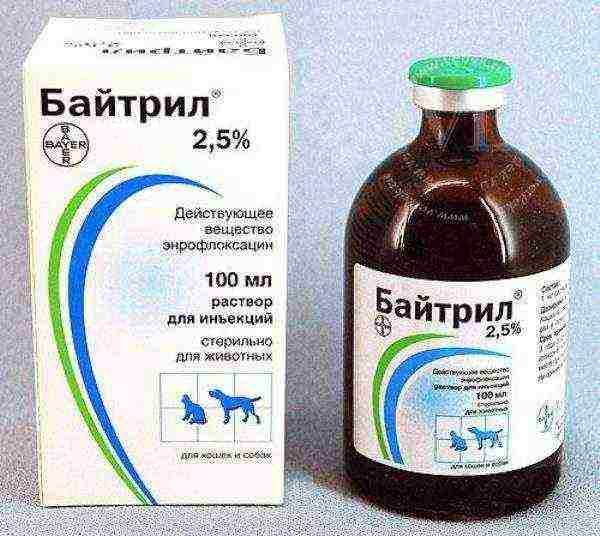
Baytril is indicated for the following infectious diseases:
- For treatment myxomatosis;
- Infectious respiratory system damage;
- Infectious stomach diseases and intestines;
- Infectious lesions of the genitourinary system;
- Septicemia;
- Colibacillosis;
- Salmonellosis;
- Streptococcosis;
- For pneumonia treatment with a bacterial or enzootic character;
- With rhinitis atrophic type;
- With others infectious pathologistsd, which are caused by pathogens with a high level of sensitivity to fluoroquinolones. In diseases with a mixed nature and infections of the secondary type that arose during diseases of the viral type.
Composition and release form of the drug
The main component of the drug is enrofloxacin.
IN depending on the dosage, 1 ml of Baytril contains:
- With a dosage of 2.5% contains 25 mg of enrofloxacin;
- With a dosage of 5% - 50 mg of enrofloxicin;
- With a dosage of 10% - 100 mg of enrofloxicin.

The composition includes additional components:
- Potassium hydroxide;
- N-butanol;
- Ethanol;
- Water for injections.
Regardless of the dosage, the agent bytril is available as a solution with a light yellow color that has a transparent structure. Sterile. On sale, it is found in 100 ml bottles made of a brown glass base. The vials are placed in a cardboard box. There is a marking on the packaging and bottles... The marking consists of the name of the product, the manufacturer, the address, the serial number, the date of issue, the indication of the storage conditions (from 5 degrees Celsius to 25 degrees Celsius above zero), the indication of the expiration date (usually no more than 3 years), TU. The package contains instructions. After opening, the medicine can be stored for 28 days, but not more.
Pharmacological properties of the drug
The main component of the drug is enroflaxicin. This substance belongs to the group of fluoroquinolones. It has a wide spectrum of antimycoplasmic and antibacterial effects on infectious agents. When ingested, it inhibits the growth and development of bacteria. These bacteria include the following microorganisms:
- Escherichia;
- Salmonella;
- Hemophilus;
- Pasteurella;
- Staphylococci;
- Streptococci;
- Bordetella;
- Clostridia;
- Pseudomonas;
- Campylobacter;
- Proteus;
- Corinebacteria;
- Mycoplasma.
The principle of the mechanism of action of the main component is based on the effect of the enzyme gyrase with inhibited activity on the replication of the DNA helix, which is located in the nucleus of the bacterial cell.
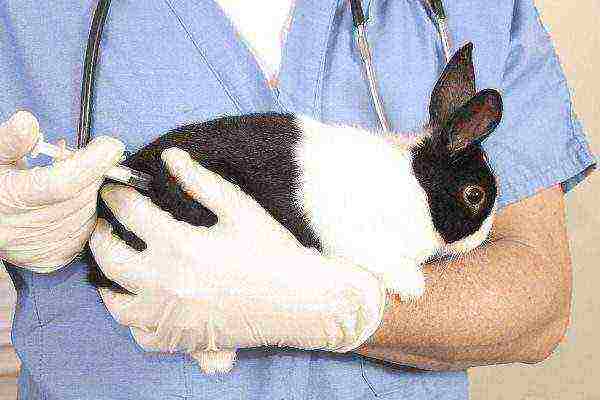
During injection, the drug is rapidly absorbed into all tissues, and instantly spreads throughout the animal's body. Duration of concentration the drug in the blood is 30-40 minutes. The level of therapeutic concentration in the body lasts up to 24 hours. The drug is excreted by the kidneys unchanged.
Instructions for use of the drug
How to apply for babies
Before you start using Baytril, you should pay attention to the symptoms of the course of one or another infectious disease. Cubs should be given baytril for healingif they have the following symptoms:
- Rabbits become lethargic;
- Bad or complete lack of appetite;
- Emergence diarrhea;
- Individuals sneeze and cough;
- Increased watery eyes;
- Allocations from the eyes and nose;
- Rabbits are constantly sit motionless in the corner of the cage;
- Increased body temperature... Their skin is hot to the touch, sometimes even fiery.
Therefore, so that these symptoms do not lead to death, and the disease does not turn into a severe stage, timely treatment is necessary... In addition, the use of Baytril will help protect against the appearance of infections, so it can be used for preventive treatment.
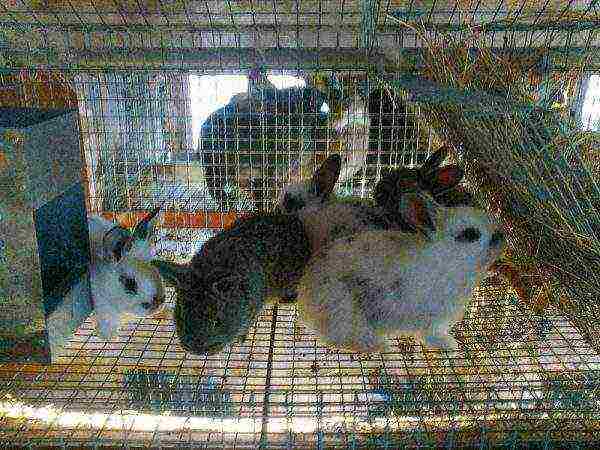
Before starting treatment, it is worth doing the following mandatory preparatory actions:
- Sick individuals are deposited from healthy rabbits... It is best to transplant them into a separate cage;
- Cellwhere the animals are kept, good cleaned and poured with hot water;
- Drinkers should be rinsedb and change the water in them to clean;
- Litter in cells it is cleaned;
- Residues of feed, grass, hay, vegetables constantly thrown out.
How to use Baytril for babies:
- Applying Baytril to the Hatchlings starts at the age of one month;
- If you have infections the drug is used in the form of injections... Because this method provides the greatest absorption of the drug;
- Better to introduce in the back of the thigh a rabbit;
- Dose of medication with 5% dosage, for babies is 1-2 mg;
- A course of treatment is 5 days;
- For preventive treatment the drug is added to the water. For 10 liters of water, add 5 ml of 10% bytril. However, this method of application can seriously harm the microflora of the animal.
How to give the drug to adults
Before you start treatment of adult rabbits Bytril preparation should also be addressed to the general condition of the individuals. If you notice that the animals have become less active, their appetite has disappeared, their temperature has risen, and diarrhea has developed, then this will be the main signal that your pets have contracted some kind of infectious disease. Appropriate measures are immediately taken to eliminate them.
It is better to pre-protect your offspring from infection with infections and to carry out prophylaxis using the drug Baytril.
Without fail Before starting treatment, take the following measures:
- Sick animals are better off. in a separate cell, otherwise they will infect other healthy individuals;
- The cage, which contains the rabbits, is carefully cleaned and cleared of all debris. She's all poured with hot water;
- Drinkers are all well rinsedI, the water in them must always be clean;
- Remains of feed mixtures, grass, vegetables are periodically cleaned.
How to apply baytril for adults:
- Adults are given with the help injection;
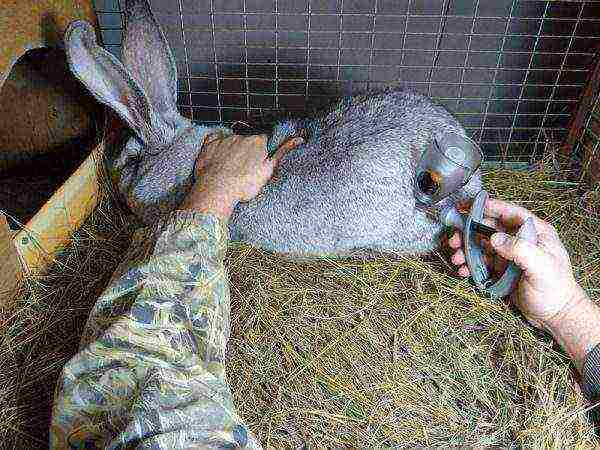
- It should be entered in the back of the thigh a rabbit;
- Adult rabbits a 5% drug is introduced at a dosage of 5 mg;
- A course of treatment should be no more than 5 days;
- As a preventive measure it is added to water, 5 ml of 10% bytril is added to 10 liters.
Side effects
Generally the drug Baytril is well tolerated by rabbits... If you follow the dosage and course of treatment exactly, then side effects do not occur. Sometimes, while taking the medicine with water, problems associated with upsetting the work of the gastrointestinal tract can be observed, but they quickly pass. This is due to the fact that the constituent components of the drug affect the microflora of the stomach of rabbits.
Contraindications
Baytril is contraindicated in rabbits under the following conditions:
- Not recommended for females during pregnancy and lactation;
- Newborn cubs;
- To animals that have increased sensitivity to the active ingredient of the drug;
- Individuals with pathology of the nervous system;
- With hepatic and renal impairment;
- If any cartilage damage.
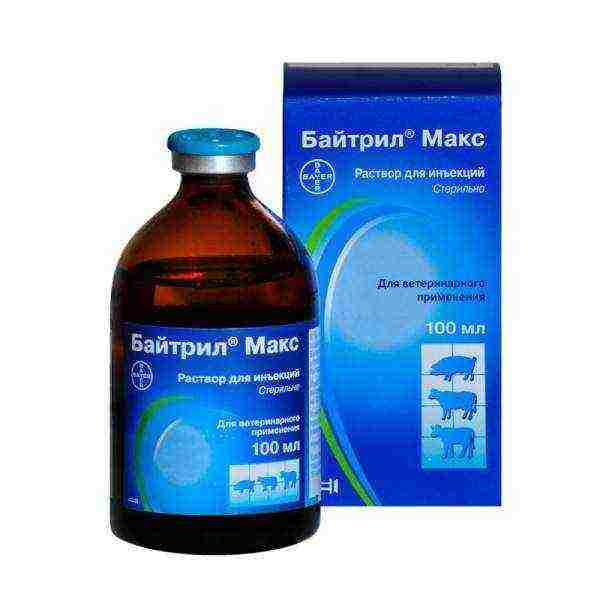
It is not recommended to use with non-steroidal anti-inflammatory drugs:
- Theophylline;
- Tetracycline;
- Macrolides;
- Levomycetin.
Price
average cost in many veterinary pharmacies, one 100 ml bottle of Baytril with dosages of 2.5% and 5% ranges from 260 rubles to 380 rubles. The cost of the drug for one bottle of 100 ml with a dosage of 10% ranges from 600 rubles to 770 rubles.
Using bytril for the treatment and prevention of various infectious diseases in rabbits should be performed according to the instructions. It is advisable to use it once a year to protect your offspring from being affected by various dangerous infectious diseases. Also, do not forget to observe the correct conditions for keeping animals during treatment. The feed during this period should contain the necessary vitamins to enhance the immune system of the animals.
